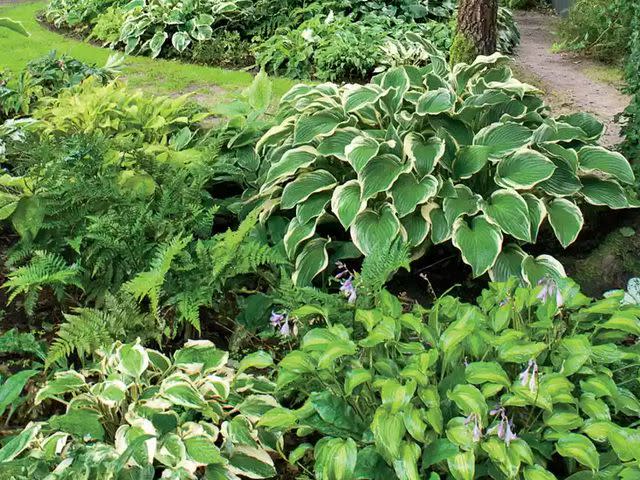Perfect Pairings: Plants You Should Plant Together
Finding the right combination of plants to make your garden shine is no easy task. Fortunately, gardeners have experimented with different plant arrangements for centuries. All that trial and error has taught us that some plants are meant to be planted together. As you head out to tackle your entryway garden or patio plantings, take the guess work out of design with these perfect pairings.

SIMONE AUGUSTIN/GAP PHOTOS
Elegant Shrub Combo: Hydrangea and Boxwood
One is flashy, buoyant, bold. The other sophisticated and refined. Together they make garden magic. From formal plantings to country chic, hydrangeas and boxwoods are the perfect combo. And they combine in endless ways. Try framing a planting of hydrangeas with a boxwood hedge—clipped to perfection for a more formal look or loose and natural for cottage style plantings. Don’t be shy about repeating this combo for the entire length of a planting bed, entire gardens have been created based on this theme. For a fuss-free combo, try pairing White Wedding® Hydrangea (Hydrangea paniculata 'LeeP1') with Baby Jade™ Boxwood (Buxus microphylla var. japonica 'Grejade').
Classic Climbers: Clematis and Roses
On arbors, archways, and fences, climbing roses and clematis are a classic pairing. They combine well for several reasons. First, they have the same needs: plenty of sunshine, moist, well-draining soils, and occasional feeding. They also complement one another visually. Clematis’ large petals contrast with the rumpled petals of a rose, while their bold foliage hides the often leggy stems of a climbing rose. And of course, there are endless color combinations. Look for clematis varieties that require spring pruning (clematis pruning group three) to correspond to the needs of roses. And consider flower timing, pairing varieties that bloom at the same time. For roses, repeat bloomers and those with longer bloom cycles work well. One of many combinations includes the vibrant purple Clematis viticella 'Etoile Violette' with the sunny blooms of Rosa 'Golden Showers'.
Made in the Shade: Hosta and Ferns
One of the secrets to successful plant pairing is to combine plants that visually contrast with one another. This contrast might be in the form of color, size, form, or texture. Such contrast is what makes hosta and fern such a dynamic duo. A soft bed of fine-cut fern foliage makes the bold, broad leaves of hosta stand out. Add contrasting colors to this pairing for even more impact. Hostas and some ferns come in an array of colors. For a truly striking combo plant a purple-hued Japanese Painted Fern (Athyrium niponicum) with a chartreuse-colored hosta such as 'Sunny Halcyon' or 'Appletini'. For a more subdued look, plant a backdrop of Autumn fern (Dryopteris erythrosora) behind a large hosta such as 'Great Expectations'. Make this duet a trio by adding low-growing purple Heuchera.
Sun-Loving Perennial Pairing: Echinacea and Agastache
The broad, daisy-like blooms of coneflower look fabulous among spikes of purple flowers. The shapes and textures work together harmoniously, such that each flower looks better than if planted solo. In addition to Agastache, other species also work well alongside coneflowers. Form is the key—look for plants that produce long floral spikes such as those of liatris, certain salvias, Russian sage, and even veronicas, depending on the size of your echinacea. 'Magnus' purple coneflower (Echinacea purpurea) is an older variety that has proven itself again and again. Try pairing it with 'Blue Fortune' hummingbird mint (Agastache hybrid).
Autumn Glory: Goldenrod and Ironweed
Complement fall foliage with a vibrant planting of goldenrod and ironweed. You can never go wrong with pairing complementary colors in the garden: green with red, orange with blue, and in this case, purple with yellow. Not only do goldenrod and ironweed add vibrant color to the garden, but they are also beloved by pollinators. Watch for American lady and swallowtail butterflies collecting nectar from ironweed. Migrating monarchs often stop to feed on goldenrod, as do many other beneficial insects. A proven combo pairs 'Iron Butterfly' ironweed (Vernonia lettermanii) with 'Peter Pan' goldenrod (Solidago virgaurea).
Sunny Container Combo: Cordyline and Petunias
While there are many proven container recipes to choose from, one technique to consider is color echo. This involves repeating colors across the plants within the container. The most successful way to do this is focus on color in different parts of the plant, such as leaves and flowers. For example, the burgundy-red hues of 'Red Sensation' cordyline (Cordyline australis) echo the dark eye of Supertunia® Latte™ (Petunia hybrid). This pairing also combines long, upright leaf blades with tumbling foliage and flowers, for a traditional “spiller and thriller” container combo with loads of texture.
For more Southern Living news, make sure to sign up for our newsletter!
Read the original article on Southern Living.

